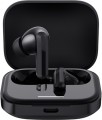Game mode (low input lag)
A special game mode in wireless headphones that minimizes the delay in transmitting an audio track from a connected source.
Low Input Lag) provides the ability to quickly respond to what is happening in virtual battles and prevents the picture from being out of sync with the sound. At the same time, when you activate the game mode, wireless headphones will be discharged faster.
Microphone noise canceling
The presence of a noise reduction system in its own headphone microphone.
In accordance with the name, such a system is designed to eliminate extraneous noise - primarily during conversations. It is usually based on an electronic filter that passes the sound of a human voice and cuts off background sounds such as city noise, the rumble of wind in the microphone grille, etc. As a result, even in noisy environments, thanks to the
noise reduction of the microphone, speech is clear and intelligible; True, the system inevitably introduces distortions into the final sound, but they are not critical in this case.
— ENC. ENC (Environment Noise Cancellation) technology significantly reduces ambient noise with directional microphones. It is used both in gaming devices so that gamers can easily communicate in voice chat, and in TWS earphone models so that you can comfortably talk on the phone in a noisy environment.
— cVc. Microphone noise reduction cVc (Clear Voice Capture) is an advanced technology that is found mainly in expensive headphone models. cVc algorithms effectively suppress echo and noise from the environment. Sound processing using this technology is carried out at several levels at once - the algorithm determines the reference signal-to-noise level, automatically adjusts speech to the desired volume level, applies adaptive equalizers to process the entire voice, as well as specialized filters to remove
...low-frequency bubbling, sibilants and hissing.Mobile app
The ability to operate the functions and settings of headphones through
a mobile application for a smartphone or tablet. Communication between the device and gadgets is usually carried out via the Bluetooth wireless protocol. The mobile application may provide tools for flexible sound settings (equalizer, bass boost, etc.), switching noise reduction and transparency modes, reassigning buttons and gestures, finding lost headphones, etc. Also, the ability to update the headphone firmware is often implemented through the mobile application.
Multipoint
A technology used in Bluetooth models (see "Connection") that allows the headphones to connect to multiple devices at the same time. Thanks to this, you can, for example, listen to music from a laptop, and when a call comes in on a mobile phone, switch the headphones to a conversation. This technology has its own characteristics for different manufacturers, and therefore, if the
multipoint function is critical for you, you should separately clarify the details of its operation in the selected model.
Headphone search
The search function will come in handy if the headphones are missing somewhere and you cannot find them. It is implemented, as a rule, through a smartphone application. In the programme interface, just press the search button and both headphones will immediately start emitting a loud signal. The second option for implementing the
headphone search function is to track the last location of the headphones according to GPS satellites.
Headphone battery capacity
The capacity of the battery installed in the headphones of the corresponding design (see "Power").
Theoretically, a higher capacity allows to achieve greater battery life, but in fact, the operating time also depends on the power consumption of the headphones — and it can be very different, depending on the characteristics and design features. So this parameter is secondary, and when choosing it is worth paying attention not so much to the battery capacity, but to the directly claimed operating time (see below).
Case battery capacity
The capacity of the battery installed in the case (case) for headphones.
This parameter is relevant only for true wireless models (see "Cable type"). Recall that these headphones are charged from a case, which is usually equipped with its own battery and actually works in standalone power bank mode. Knowing the capacity of the battery in the case and in the headphones, you can estimate how many charges of the “ears” will last for one charge of the case. However, it should be taken into account that in the process of charging the headphones, part of the energy is inevitably spent on third-party losses, and the effective capacity of the case turns out to be somewhere 1.6 times less than the claimed one. This is the starting point for calculations: for example, a 300 mAh case will actually be able to transfer 300 / 1.6 = 187 mAh of energy to the headphones, and 30 mAh “ears” from such a battery can be fully charged about 6 times (187 / 30 ≈ 6).
Operating time (talk)
The maximum battery life of headphones on one full charge of the battery or replaceable batteries in talk mode. A long working time will be relevant for those who expect to regularly conduct long telephone conversations. Note that in talk mode, autonomy may be lower than when listening to music, since the use of microphones and clear voice transmission algorithms puts an additional burden on the hardware of the headphones.
Operating time (no noise canceling)
How long does the active noise canceling headphones (see above) last on a single battery charge (or a set of batteries) when noise canceling is not used.
This function is quite “gluttonous” in terms of battery consumption, up to half of the total energy consumed by the headphones can go to its work. Thus, models with noise reduction can indicate both overall battery life (see "Operating time"), and battery life with the noise reduction turned off.

